-
Notifications
You must be signed in to change notification settings - Fork 115
Tutorial Distributors
Distributors are modules that are useful for placing multiple copies of a child across a line, area, volume, or ring. Many transforms have one or more distributive variation.
| Transforms | Related Distributors |
|---|---|
left(), right()
|
xcopies() |
fwd(), back()
|
ycopies() |
down(), up()
|
zcopies() |
move(), translate()
|
move_copies(), line_copies(), grid_copies()
|
xrot() |
xrot_copies() |
yrot() |
yrot_copies() |
zrot() |
zrot_copies() |
rot(), rotate()
|
rot_copies(), arc_copies()
|
xflip() |
xflip_copy() |
yflip() |
yflip_copy() |
zflip() |
zflip_copy() |
mirror() |
mirror_copy() |
Using xcopies(), you can make a line of evenly spaced copies of a shape
centered along the X axis. To make a line of 5 spheres, spaced every 20
units along the X axis, do:
include <BOSL2/std.scad>
xcopies(20, n=5) sphere(d=10); Note that the first expected argument to
Note that the first expected argument to xcopies() is the spacing argument,
so you do not need to supply the spacing= argument name.
Similarly, ycopies() makes a line of evenly spaced copies centered along the
Y axis. To make a line of 5 spheres, spaced every 20 units along the Y
axis, do:
include <BOSL2/std.scad>
ycopies(20, n=5) sphere(d=10);
And, zcopies() makes a line of evenly spaced copies centered along the Z axis.
To make a line of 5 spheres, spaced every 20 units along the Z axis, do:
include <BOSL2/std.scad>
zcopies(20, n=5) sphere(d=10);
If you don't give the n= argument to xcopies(), ycopies() or zcopies(),
then it defaults to 2 (two) copies. This actually is the most common usage:
include <BOSL2/std.scad>
xcopies(20) sphere(d=10);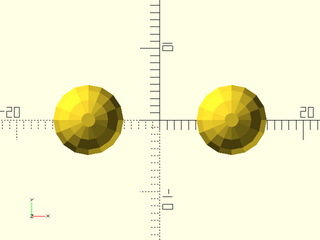
include <BOSL2/std.scad>
ycopies(20) sphere(d=10);
include <BOSL2/std.scad>
zcopies(20) sphere(d=10);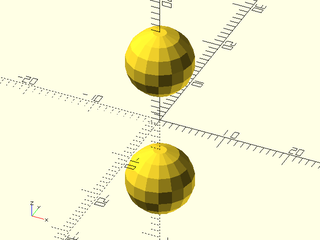
If you don't know the spacing you want, but instead know how long a line you
want the copies distributed over, you can use the l= argument instead of
the spacing= argument:
include <BOSL2/std.scad>
xcopies(l=100, n=5) sphere(d=10);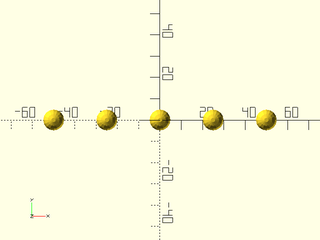
include <BOSL2/std.scad>
ycopies(l=100, n=5) sphere(d=10);
include <BOSL2/std.scad>
zcopies(l=100, n=5) sphere(d=10);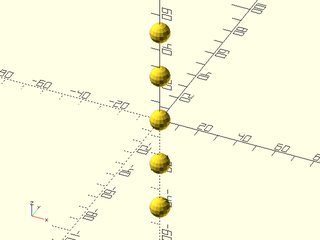
If you don't want the line of copies centered on the origin, you can give a
starting point sp=, and the line of copies will start there. For xcopies(),
the line of copies will extend to the right of the starting point.
include <BOSL2/std.scad>
xcopies(20, n=5, sp=[0,0,0]) sphere(d=10);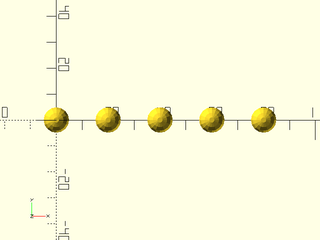
For ycopies(), the line of copies will extend to the back of the starting point.
include <BOSL2/std.scad>
ycopies(20, n=5, sp=[0,0,0]) sphere(d=10);
For zcopies(), the line of copies will extend upwards from the starting point.
include <BOSL2/std.scad>
zcopies(20, n=5, sp=[0,0,0]) sphere(d=10);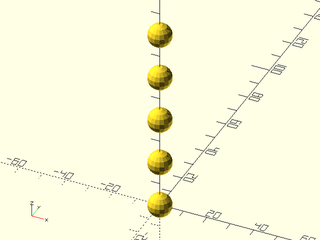
If you need to distribute copies along an arbitrary line, you can use the
line_copies() command. You can give both the direction vector and the spacing
of the line of copies with the spacing= argument:
include <BOSL2/std.scad>
line_copies(spacing=(BACK+RIGHT)*20, n=5) sphere(d=10);
With the p1= argument, you can specify the starting point of the line:
include <BOSL2/std.scad>
line_copies(spacing=(BACK+RIGHT)*20, n=5, p1=[0,0,0]) sphere(d=10);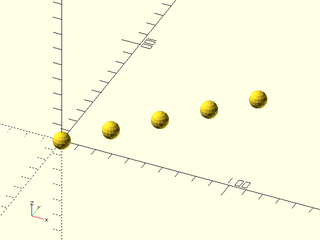
If you give both p1= and p2=, you can nail down both the start and
endpoints of the line of copies:
include <BOSL2/std.scad>
line_copies(p1=[0,100,0], p2=[100,0,0], n=4)
sphere(d=10);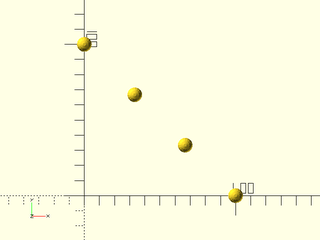
The grid_copies() command will let you spread copies across both the X and Y
axes at the same time:
include <BOSL2/std.scad>
grid_copies(20, n=6) sphere(d=10);
The spacing can be separately specified for both the X and Y axes, as can the count of rows and columns:
include <BOSL2/std.scad>
grid_copies([20,30], n=[6,4]) sphere(d=10);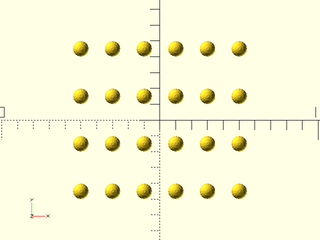
Another neat trick of grid_copies(), is that you can stagger the output:
include <BOSL2/std.scad>
grid_copies(20, n=[12,6], stagger=true) sphere(d=10);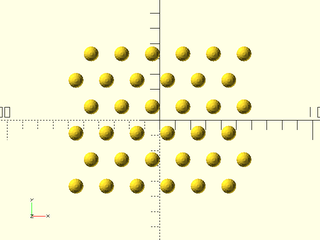
You can get the alternate stagger pattern if you set stagger="alt":
include <BOSL2/std.scad>
grid_copies(20, n=[12,6], stagger="alt") sphere(d=10);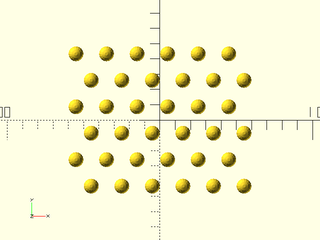
By default, if you give a scalar for the spacing value, staggering will give you a hexagonal grid, with the spacing being the distance from an item to all six of the surrounding items. If you give the spacing as a 2-item vector, then that will force the X and Y spacings between columns and rows instead.
include <BOSL2/std.scad>
grid_copies([20,20], n=6, stagger=true) sphere(d=10);
You can alternately specify a grid using size and spacing:
include <BOSL2/std.scad>
grid_copies(20, size=100) sphere(d=10);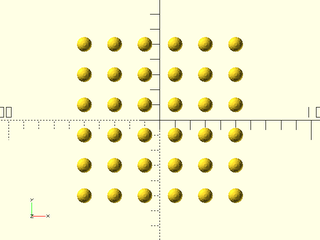
include <BOSL2/std.scad>
grid_copies(20, size=[100,80]) sphere(d=10);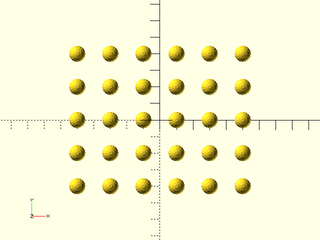
include <BOSL2/std.scad>
grid_copies(20, size=[100,80], stagger=true) sphere(d=10);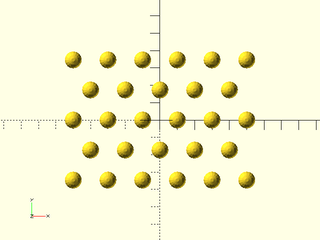
You can also make grids by specifying size and column/row count:
include <BOSL2/std.scad>
grid_copies(n=5, size=100) sphere(d=10);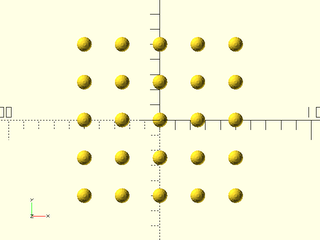
include <BOSL2/std.scad>
grid_copies(n=[4,5], size=100) sphere(d=10);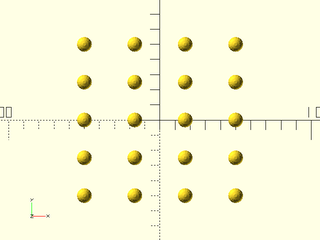
include <BOSL2/std.scad>
grid_copies(n=[4,5], size=[100,80]) sphere(d=10);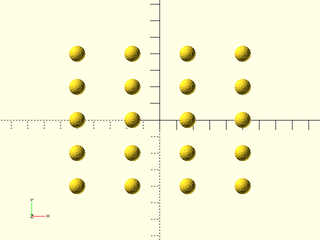
Finally, the grid_copies() command will let you give a polygon or region shape
to fill with items. Only the items in the grid whose center would be inside
the polygon or region will be created. To fill a star shape with items, you
can do something like:
include <BOSL2/std.scad>
poly = [for (i=[0:11]) polar_to_xy(50*(i%2+1), i*360/12-90)];
grid_copies(5, stagger=true, inside=poly) {
cylinder(d=4,h=10,spin=90,$fn=6);
}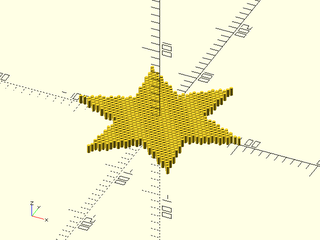
You can make six copies of a cone, rotated around a center:
include <BOSL2/std.scad>
zrot_copies(n=6) yrot(90) cylinder(h=50,d1=0,d2=20);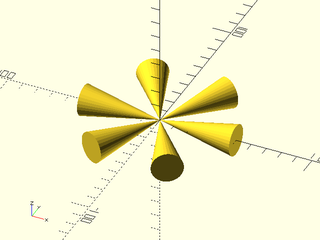
To Be Completed
Table of Contents
Function Index
Topics Index
Cheat Sheet
Tutorials
Basic Modeling:
- constants.scad STD
- transforms.scad STD
- attachments.scad STD
- shapes2d.scad STD
- shapes3d.scad STD
- drawing.scad STD
- masks2d.scad STD
- masks3d.scad STD
- distributors.scad STD
- color.scad STD
- partitions.scad STD
- miscellaneous.scad STD
Advanced Modeling:
- paths.scad STD
- regions.scad STD
- skin.scad STD
- vnf.scad STD
- beziers.scad
- nurbs.scad
- rounding.scad
- turtle3d.scad
Math:
- math.scad STD
- linalg.scad STD
- vectors.scad STD
- coords.scad STD
- geometry.scad STD
- trigonometry.scad STD
Data Management:
- version.scad STD
- comparisons.scad STD
- lists.scad STD
- utility.scad STD
- strings.scad STD
- structs.scad STD
- fnliterals.scad
Threaded Parts:
Parts:
- ball_bearings.scad
- cubetruss.scad
- gears.scad
- hinges.scad
- joiners.scad
- linear_bearings.scad
- modular_hose.scad
- nema_steppers.scad
- polyhedra.scad
- sliders.scad
- tripod_mounts.scad
- walls.scad
- wiring.scad
STD = Included in std.scad